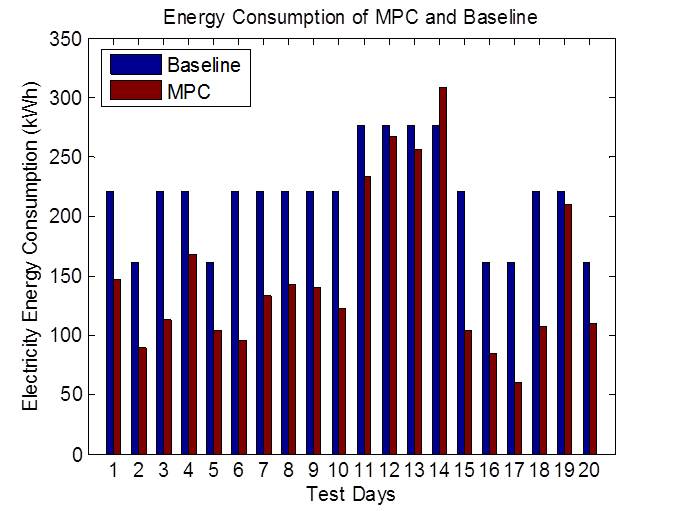How CBEI is Engineering Smarter Buildings
Original research by Dr. James Braun, Professor of Engineering at the School of Mechanical Engineering, Purdue University
What Is an “Intelligent” Building?
Intelligent buildings provide optimal controls and automated diagnostic systems leading to substantial energy savings, reliable system performances, and improved occupant comfort. They are undoubtedly a “smart” choice for building owners.
Despite the benefits, high installation costs have curtailed the market for the high-level features characteristic of intelligent buildings. At the ASHRAE national meeting from June 20-23, 2013 the EEB Hub hosted the Intelligent Building Operations Workshop to discuss technological solutions that enable scalable and cost-effective intelligent building operations (IBO). CBEI Intelligent Buildings Operations Task researchers gave many of the workshop presentations.

An EEB Hub experimental virtual gauge display for a rooftop unit.
To erect and operate a building requires a substantial amount of labor: years of work from architects, engineers, and contractors, and the oversight of building managers for the duration of its lifecycle. With human labor come opportunities for human error that, combined with equipment problems and improper building management, can result in building systems not operating optimally. In fact, building systems often show steadily declining performances over time, which suggests the need for better quality control processes.
Every building is unique, constructed and operated by its own particular combination of investors and personnel. Therefore, every building needs its own particular quality control process to ensure consistent and efficient operation. The automated error diagnostics and control systems that characterize intelligent buildings are designed to correct energy-draining errors caused by design flaws, mismanagement, or system malfunctions. Such building performance assessments can make building functions transparent, allowing owners and facility managers to stay informed about the efficiency of the building.
CBEI Research into Intelligent Building Operations
Fortunately, a growing body of work shows that integrated design can overcome many of these systemic barriers. The objective of the CBEI IBO research is to integrate and demonstrate scalable and low-cost technologies to optimize building operations. The IBO team has already developed a set of tools that can reduce the installation costs of optimizing building control and diagnostics systems and is now working to show the practical benefits of intelligent buildings. To accomplish this, the CBEI team is developing and demonstrating a prototype building operations platform for advanced energy retrofit (AER) demonstration sites that connects to the building control system in a standardized manner and enables cost-effective implementation of cloud-based advanced applications, such as optimal control systems, automated diagnostics, and advanced human-machine interfaces. The platform and advanced applications will enable 20-30% savings in building energy use.
Optimal Control Systems
Building control systems have been implemented for decades. These systems centralize the control functions, such as HVAC and lighting, making it far easier to manage conditions. At a supervisory level, the control systems provide set points to local-loop controllers and schedules for equipment operation; lights and heat may turn on at 7am and turn off at 6pm, for example. Advances in control algorithms and improved, less-expensive sensors are now making it possible to take building controls to the next level and have them function based on real world conditions, and not simply operate on preset assumptions. These systems rely on a model predictive control structure, which takes weather, occupancy, and other sensor information and uses it to predict the conditions that will occur later in the day. This processing allows a building control system to operate optimally when heating and cooling.
CBEI is in the process of testing this type of system in Building 101 at The Navy Yard in Philadelphia. Early results have been very positive, showing a 33% reduction in energy consumption for cooling and a corresponding improvement in occupant comfort during a twenty-day test period. The energy savings resulted from improvements in the system’s dynamically set temperatures for the supply air from the air handling units and various building zones.
Diagnostics/Monitoring
Sensors that measure certain conditions – e.g. light levels, temperatures – have become more available in recent years. However, when it comes to high-ticket building components, there is a noted lack of sensor technology to monitor equipment operation, diagnose issues, and evaluate the impact of equipment faults.
CBEI is working to fill this gap. Looking at variable air volume air-handling units (VAV AHUs) and roof-top units (RTUs), researchers are testing both data-driven and virtual sensor methods. Virtual sensors rely on easily measured conditions to measure other conditions that cannot easily or cost-effectively be measured directly. For example, researchers have been able to accurately estimate refrigerant charge and equipment fouling in RTUs by measuring temperatures at several positions within the unit. This research is leading the way to what may one day be the standard for this type of equipment. Improved measurement and diagnostics will ensure that buildings are operating efficiently and can keep equipment in good working condition and extend its lifetime.
Barriers to Implementing Intelligent Building Operations
The AEC industry is fragmented. The only way to accurately calibrate intelligent systems to a building is to integrate many of the design, construction, and operations processes, a strategy that has not yet been fully embraced in the fragmented AEC industry.
The building industry is conservative. Building owners tend to be risk averse and skeptical of the simulation data that quantify the future benefits of installing intelligent building systems.
Building owners are more attracted to retrofit options with lower front-end costs. In leased buildings where tenants pay their own energy costs, owners do not have as much incentive to invest in expensive energy-saving installations. In owner-occupied buildings, intelligent building retrofits compete for capital with less risky and less expensive investment options.
Energy in the United States is relatively inexpensive, so energy savings are not always enough of an incentive to justify the high installation costs of IBO.
